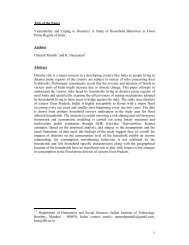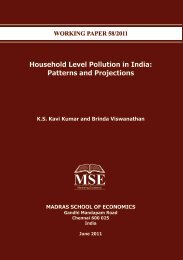A Macro-Fiscal Modeling Framework for Forecasting and Policy ...
A Macro-Fiscal Modeling Framework for Forecasting and Policy ...
A Macro-Fiscal Modeling Framework for Forecasting and Policy ...
Create successful ePaper yourself
Turn your PDF publications into a flip-book with our unique Google optimized e-Paper software.
In the case of a pure structural change model (by letting p =0, which is relevant<br />
in our case), the estimates of ˆ uˆ<br />
,<br />
t<br />
<strong>and</strong> S T (T 1 ,..,T m ) can be obtained using OLS segment<br />
by segment. The dynamic programming approach is then used to evaluate which<br />
partition achieves a global minimization of the overall SSRs. This method proceeds via a<br />
sequential examination of optimal one break (or 2 segments) partitions. Let SSR (T r , n ) be<br />
the SSRs associated with the optimal partition containing r breaks using first n<br />
observations. The optimal partition solves the following recursive problem:<br />
SSR (T m , T ) = min [SSR (T m-1 , j ) + SSR (j+1, T)] (2.11)<br />
where, mh j T – h. The procedure involves the following steps:<br />
(i) Evaluating the optimal one break partition <strong>for</strong> all sub samples that allow a possible<br />
break ranging from observations h to T – mh. That is, the first step is to store a set<br />
of T – (m+1)h + 1 optimal one break partitions along with their associated SSRs.<br />
Each of the optimal partitions correspond to sub samples ending at dates ranging<br />
from 2h to T – (m-1)h.<br />
(ii) Then, searching <strong>for</strong> optimal partitions with 2 breaks. Such partitions have ending<br />
dates ranging from 3h to T – (m-2) h. For each of these possible ending dates the<br />
procedure looks at which one break partition can be inserted to achieve a minimal<br />
SSR. The outcome is a set of T–(m+1)h + 1 optimal two breaks partitions. The<br />
method continues sequentially until a set of T – (m+1) h + 1 optimal m-1 breaks<br />
partitions are obtained ending dates ranging from (m-1) h to T – 2h.<br />
(iii) Finally, verifying which of the optimal m-1 breaks partitions yields an overall minimal<br />
SSR, when combined with an additional segment. That is, it is sequentially updating<br />
T – (m+1) h + 1 segments in to optimal one, two <strong>and</strong> up to m-1 breaks partitions<br />
<strong>and</strong> create a single optimal m breaks partition.<br />
To select the dimension of a model, various in<strong>for</strong>mation criteria are proposed in<br />
the literature. For instance, Yao (1988) suggests the Bayesian In<strong>for</strong>mation Criterion<br />
(BIC), Liu et al., (1977) proposed a modified Schwarz Criterion (LWZ) <strong>and</strong> Bai <strong>and</strong> Perron<br />
(1998) suggested the sequential application of the supF T ( 1 )<br />
Perron (1998) sequential procedure of the supF test is widely applied.<br />
test. However, Bai <strong>and</strong><br />
The general <strong>for</strong>m of supF type test is designed to test <strong>for</strong> no structural break<br />
(m=0) versus a fixed number of breaks, k. Let (R) ‟ ‟ ‟<br />
= ( 1 - 2 ,……., ‟ k - ‟ k+1) <strong>and</strong> the<br />
break fractions i = T i / T. The F statistics is defined as:<br />
31



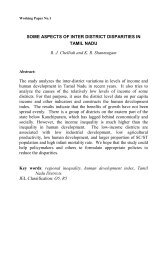

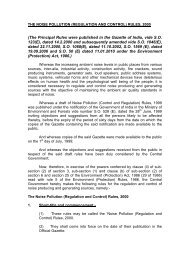
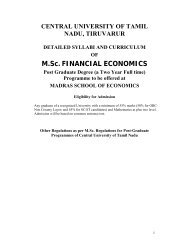
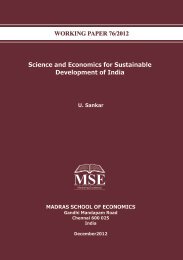
![Curriculum Vitae [pdf] - Madras School of Economics](https://img.yumpu.com/49878970/1/190x245/curriculum-vitae-pdf-madras-school-of-economics.jpg?quality=85)
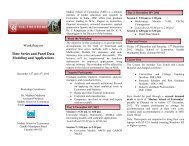
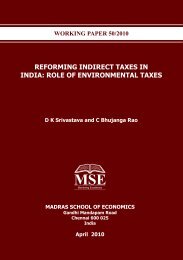
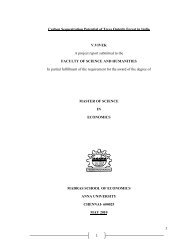
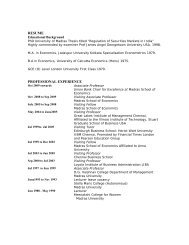
![Curriculum Vitae [pdf] - Madras School of Economics](https://img.yumpu.com/48715201/1/184x260/curriculum-vitae-pdf-madras-school-of-economics.jpg?quality=85)
